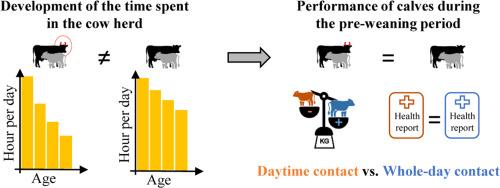Calf presence in the cow herd: Associations with growth, health, and herd horn status in a cow-calf contact system
IF 1.9
3区 农林科学
Q2 AGRICULTURE, DAIRY & ANIMAL SCIENCE
引用次数: 0
Abstract
Prolonged cow-calf contact in dairy farming is receiving considerable attention. However, research on systems that allow calves to access the whole dairy herd has been limited. This study investigated the time that German Holstein calves spent daily within the dairy herd of their dams, its association with calf growth and health, and the effect of herd (horned vs. polled). The calves with whole-day contact (WDC, n= 23) could enter the herd at any time during the day, except during milking; the calves with daytime contact (DTC, n= 26) had only access between morning and evening milking. Calves with no herd contact (NOC, n= 42) served as a control. Calves were weighed weekly and their health status was assessed. Between the 2nd and 11th weeks of life, the time spent in the cow herd decreased in WDC calves (h d-1, horned WDC: - 10.9, polled WDC: - 3.7, P< 0.001), but did not differ in DTC calves (P> 0.1). More time in the herd was associated with higher growth rates (P= 0.003). However, no effect of the herd was observed on calf growth or health. WDC calves had the highest growth rate compared to DTC and NOC (g d-1, 991 ± 36, 718 ± 35, 869 ± 28, respectively, P< 0.05). Unrestricted access to the cow herd resulted in individual variation in the time calves spent within the herd, with no observed effects on growth or health.

牛群中小牛的存在:在牛-小牛接触系统中与生长、健康和牛角状态的关系
在奶牛养殖中,奶牛与小牛的长期接触正受到相当大的关注。然而,关于允许小牛进入整个奶牛群的系统的研究一直很有限。本研究调查了德国荷斯坦小牛每天在其水坝的奶牛群中度过的时间,其与小牛生长和健康的关系,以及牛群的影响(有角vs有轮)。全天接触的小牛(WDC, n= 23)除挤奶期间外,全天任何时间均可进入牛群中;白天接触的小牛(DTC, n= 26)仅在早晚挤奶之间接触。与牛群没有接触的小牛(NOC, n= 42)作为对照。小牛每周称重并评估其健康状况。在第2周至第11周之间,WDC犊牛在牛群中度过的时间减少了(h -1,有角WDC: - 10.9,有轮WDC: - 3.7, P< 0.001),但DTC犊牛没有差异(P> 0.1)。在畜群中待的时间越长,生长速度越快(P= 0.003)。然而,没有观察到畜群对小牛生长或健康的影响。与DTC和NOC相比,WDC犊牛的生长率最高(g d-1、991±36、718±35、869±28,p < 0.05)。不受限制地进入牛群导致小牛在牛群中度过的时间存在个体差异,未观察到对生长或健康的影响。
本文章由计算机程序翻译,如有差异,请以英文原文为准。
求助全文
约1分钟内获得全文
求助全文
来源期刊

Livestock Science
农林科学-奶制品与动物科学
CiteScore
4.30
自引率
5.60%
发文量
237
审稿时长
3 months
期刊介绍:
Livestock Science promotes the sound development of the livestock sector by publishing original, peer-reviewed research and review articles covering all aspects of this broad field. The journal welcomes submissions on the avant-garde areas of animal genetics, breeding, growth, reproduction, nutrition, physiology, and behaviour in addition to genetic resources, welfare, ethics, health, management and production systems. The high-quality content of this journal reflects the truly international nature of this broad area of research.
 求助内容:
求助内容: 应助结果提醒方式:
应助结果提醒方式:


